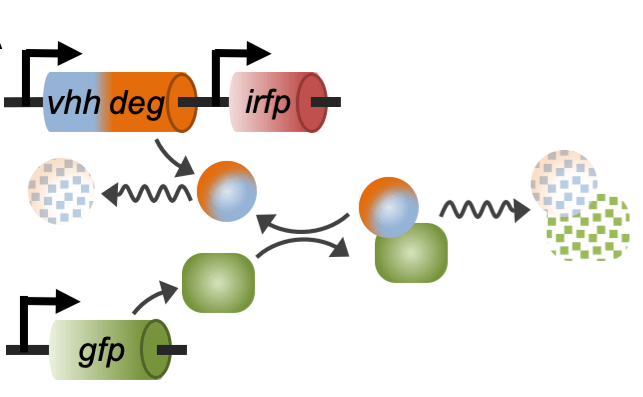Technology development: protein engineering tools for mammalian cell biology and engineering
We have developed synthetic gene networks for monitoring the activation of proteasomal degradation, enabling diverse applications including drug screening cell engineering (Nat Commun. 2014 Apr 8;5:3612). We explored the hysteretic behaviors of these synthetic gene networks, providing sustained cellular responses to transient perturbations for investigating complex cellular behavior and program cellular behaviors such as protein production and cell fate decisions (ACS Synth Biol. 2019 Sep 20;8(9):2025-2035). We have also deployed this approach to develop a yeast selection platform that links proteasomal degradation to cell survival, opening the way to high-throughput, genome-wide studies aimed at identifying modulators of proteasomal function that might provide novel targets for therapeutic applications (Protein Eng Des Sel, 2018. Nov 1;31(11):437-445).

To achieve fast, targeted, and predictable control of cellular protein levels without genetic manipulation of the target, we developed a technology for post-translational depletion based on a bifunctional molecule (NanoDeg) consisting of the antigen-binding fragment from Cemelidae species heavy-chain antibody (nanobody) and a degron signal that mediates degradation through the proteasome. Guided by predictive modeling, this technology enables quantitative and predictable control over the target’s level and can be readily used for a variety of systems-level analyses of cellular functions (ACS Synth Biol. 2018 Feb 16;7(2):540-552). We also explored the use of the NanoDeg to build synthetic genetic circuits with superior dynamic range and dynamic resolution for the design of real-time diagnostics and feedback-responsive therapeutic modalities (Methods Enzymol. 2019;621:191-212).

In collaboration with Dr Jonathan Silberg (BioSciences, Rice U), we have engineered a split transcription factor. To create a cellular sensor of protein aggregation propensity, which is extremely relevant for studying and treating human diseases as well as biotechnological applications, we also built an AND gate system based on the complementation of our engineered split transcription factor. As a result, we generated a novel genetic component that can be used for a wide range of applications in mammalian cell biology and a much-needed cell-based sensor for monitoring a protein’s conformational status in a complex cellular environment (ACS Synth Biol. 2018 Sep 21;7(9):2126-2138).
